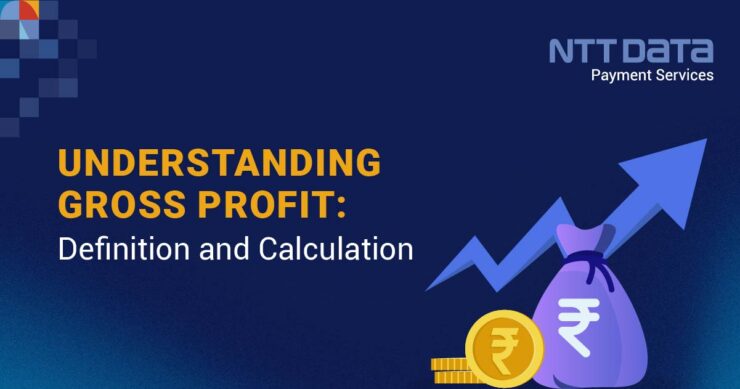
Table of Contents
- 1 Understanding Gross Profit:
- 2 Definition of Gross Profit
- 3 Recent Web Stories
- 4 Gross Profit Calculation
- 5 Calculation of Gross Profit:
- 6 What is the Gross Profit Margin?
- 7 Grow Your Gross Profit With NTT DATA Payment Services
- 8 Significance of Gross Profit
- 9 Things to Remember With Gross Profit
- 10 Assess Your Business Growth With Gross Profit
- 11 Frequently Asked Questions (FAQs)
Gross profit is an important financial metric that measures the profitability of a company’s vital operations by deducting the direct costs of producing goods or providing services from the total revenue.
Let’s comprehensively understanding gross profit, its significance, and how to calculate it.
Understanding Gross Profit:
When assessing a business’s financial health and profitability, gross profit is one of the fundamental metrics to consider. Gross profit is a key indicator that reveals how effectively a company generates revenue from its core operations.
Gross profit reveals the efficiency of a company’s production and pricing strategies. By analysing gross profit over time, businesses can gauge their ability to generate revenue from their products or services and assess their pricing strategies’ effectiveness.
Definition of Gross Profit
Gross profit represents the amount of money a company earns as profit from its core business operations after deducting the direct costs associated with producing goods or providing services. It serves as a measure of profitability before considering other operating expenses and non-operating items.
Recent Web Stories
Gross Profit Calculation
To calculate gross profit, You need two key components: revenue and cost of goods sold (COGS). Revenue represents the total sales generated by a company during a specific period, while COGS refers to the direct costs associated with producing or acquiring the goods sold.
The formula for calculating gross profit is as follows:
Gross Profit = Revenue – Cost of Goods Sold (COGS)
Revenue includes the sales revenue derived from selling products or providing services. It is essential to consider the net sales figure, which deducts any discounts, returns, or allowances from the total sales.
On the other hand, COGS comprises direct costs directly attributable to the production or acquisition of the goods sold. This includes the cost of raw materials, direct labour costs, and any other costs directly related to the manufacturing or acquisition process. Indirect costs, such as marketing expenses or administrative overheads, are not included in COGS.
Calculation of Gross Profit:
Let’s consider an example to illustrate the calculation of gross profit. Suppose a company’s revenue for a given period is $500,000, and the COGS amounts to $300,000.
Applying the formula, we have
Gross Profit = $500,000 – $300,000
Gross Profit = $200,000
In this example, the company’s gross profit is $200,000. This means that after deducting the direct costs of producing the goods sold, the company has earned $200,000 in profit solely from its core operations.
What is the Gross Profit Margin?
The gross profit margin is a financial metric that expresses the gross profit as a percentage of revenue. It measures the profitability of a company’s core operations relative to its sales. The gross profit margin is an essential indicator of a company’s ability to generate profit from its primary business activities and is widely used to assess its financial performance.
The formula for calculating the gross profit margin is as follows:
Gross Profit Margin = (Gross Profit / Revenue) x 100
While doing business, it’s important that your business can access all types of revenue streams, especially from digital platforms. Your profits will skyrocket when your digital wallets contribute to your business growth in this modern generation.
If you are a business owner or an entrepreneur, having an internet merchant account and accepting payments online is essential. Ensure your business uses a white-label payment gateway for better branding and promotion.
Grow Your Gross Profit With NTT DATA Payment Services
Growing your business means growing your profit margins and revenue. You need secure, speedy banking with quick transactions to grow your business quickly. Make your growth and banking simple and fast with NTT DATA Payment Services.
NTT DATA Payment Services offers a complete payment solution to advance your offline and online businesses from,
- Payment Gateway in India
- POS machines
- IVR payments
- Mobile applications, and
- Bharat QR Scan and Pay
We ensure maximum comfort, convenience, and safety for all your payments.
Significance of Gross Profit
Gross profit is a crucial financial metric that provides valuable insights into a company’s profitability and operational efficiency. Here are a few reasons why understanding and monitoring gross profit is essential:
1. The Measure of Efficiency:
Gross profit enables your business to assess how effectively you can convert revenue into profit, indicating your ability to manage costs and control production expenses. A higher gross profit margin suggests that a company operates efficiently and maximises profitability from its core operations.
2. Comparison and Benchmarking:
Gross profit lets your business compare its performance with industry peers or competitors. By analysing gross profit margins across similar businesses, companies can identify areas where they may lag or excel and make strategic adjustments accordingly.
3. Decision-Making:
Gross profit analysis assists management in making informed decisions about pricing strategies, product offerings, cost controls, and resource allocation. Understanding the impact of different factors on gross profit helps businesses optimise operations and drive profitability.
4. Investor and Lender Perspective:
Potential investors and lenders often examine a company’s gross profit margin to evaluate its financial stability and growth potential. A healthy and consistent gross profit margin indicates a well-managed business with a strong revenue generation capability, which can attract external investments and favourable lending terms.
Things to Remember With Gross Profit
While gross profit is a valuable metric, it is essential to recognise financial factors when assessing overall business performance. Here are a few key points to remember while calculating your gross profit.
1. Indirect Costs:
Gross profit does not account for operating expenses beyond the direct costs of producing goods or services. The net profitability of a business and operating expenses such as rent, salaries, utilities, marketing, and administrative costs must be evaluated.
2. Industry Variances:
Different industries have varying levels of gross profit margins due to variations in business models, cost structures, and market dynamics. Comparing gross profit margins across industries may not accurately assess performance.
3. Pricing and Sales Volume:
Price strategies or sales volume changes can significantly impact gross profit margins. Considering the interplay between these factors is crucial when analysing profitability trends.
Assess Your Business Growth With Gross Profit
Gross profit is a vital financial metric that provides insights into a company’s operational efficiency and revenue generation capabilities. By calculating and monitoring gross profit, businesses can assess their performance, make informed decisions, benchmark against competitors, and attract potential investors and lenders.
Understanding gross profit and its calculation is essential for entrepreneurs, business owners, and finance enthusiasts seeking to gain insights into a company’s financial health and profitability.
| Also, you can get frequent updates on nttdatapayments Instagram page. |
Frequently Asked Questions (FAQs)
- What is the meaning of gross profit calculation?
Gross profit represents the amount of money a company earns as profit from its core business operations after deducting the direct costs associated with producing goods or providing services.
- What is the formula for profit gross profit?
The formula for calculating gross profit is as follows:
Gross Profit = Revenue – Cost of Goods Sold (COGS)
Revenue includes the sales revenue derived from selling products or providing services. COGS comprises direct costs directly attributable to producing or acquiring the goods sold.
- How is gross profit or loss computed?
The gross profit is calculated by subtracting the cost of goods and services (COGS) from the total revenue. If the value is positive, it’s said to be gross profit & if the value is negative, it’s said to be gross negative.
- How is the gross profit margin calculated?
The gross profit margin is a financial metric that expresses the gross profit as a percentage of revenue. It is calculated by dividing the gross profit by revenue and multiplying the result by 100.
The formula for gross profit margin: Gross Profit Margin = (Gross Profit / Revenue) x 100
- Are gross profit and EBITDA the same?
Gross profit is the profit a company makes after subtracting the costs associated with products and services. EBITDA is the earnings that are shown before interest, taxes, depreciation, and amortisation.







